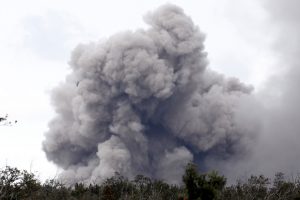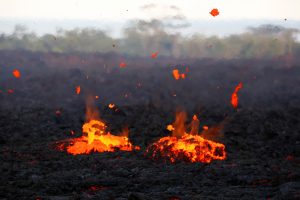
By Terray Sylvester
PAHOA, Hawaii (Reuters) – Explosions intensified on Hawaii’s Kilauea volcano on Tuesday, spewing ash and triggering a red alert for aircraft for the first time since the latest eruption began 12 days ago.

Ash erupts from the Halemaumau crater near the community of Volcano during ongoing eruptions of the Kilauea Volcano in Hawaii, U.S., May 15, 2018. REUTERS/Terray Sylvester
Ash and volcanic smog, or vog, as it is called, rose to 12,000 feet (3,657 meters) above Kilauea’s crater and floated southwest, showering cars on Highway 11 with gray dust and prompting an “unhealthy air” advisory in the community of Pahala, 18 miles (29 km) from the summit.
An aviation red alert means a volcanic eruption is under way that could spew ash along aircraft routes, the U.S. Geological Survey (USGS) says on its website.
Ash was also a new hazard for residents of Hawaii’s Big Island, already grappling with volcanic gas and lava that has destroyed 37 homes and other structures and forced the evacuation of about 2,000 residents.
A shift in winds was expected to bring ash and vog inland on Wednesday and make them more concentrated, said John Bravender of the National Oceanic and Atmospheric Administration (NOAA).
“We’re observing more or less continuous emission of ash now with intermittent, more energetic ash bursts or plumes,” Steve Brantley, a deputy scientist in charge at the Hawaiian Volcano Observatory (HVO), said on a conference call with reporters.

Kilauea volcano’s summit lava lake shows a significant drop of roughly 722 feet below the crater rim in this wide angle camera view showing the entire north portion of the Overlook crater May 6, 2018. USGS/Handout via REUTERS
The observatory warned the eruption could become more violent.
“At any time, activity may become more explosive, increasing the intensity of ash production and producing ballistic projectiles near the vent,” the HVO said in a statement on the change in aviation alert level to red from orange.
Ash is not poisonous but irritates the nose, eyes and airways. It can make roads slippery and large emissions could cause the failure of electrical power lines, said USGS chemist David Damby.
NEW FISSURE
The eruption has hit the island’s tourism industry.
Big Island summer hotel bookings have dropped by almost half from last year, Rob Birch, executive director of the Island of Hawaii Visitor Bureau, told journalists on a conference call.
College exchange student Constantin Plinke, 24, was planning to go to the Hawaii Volcanoes National Park before it was shut.
“We had a big list of things to do and maybe 80 percent of them were in the national park,” he said, after stopping by the side of the road to watch ash plumes rising into the air. “It’s sad.”
The area taking the brunt of the eruption is about 25 miles (40 km) down Kilauea’s eastern flank, near the village of Pahoa. Lava has burst from the ground to tear through housing developments and farmland, threatening one of the last exit routes from coastal areas, state Highway 132.
The latest fissure in the earth opened on Tuesday, spewing lava and toxic gases that pushed air quality into “condition red” around Lanipuna Gardens and nearby farms, causing “choking and inability to breathe,” the Hawaiian Volcano Observatory and Hawaii County Civil Defense said.
Road crews put metal plates over steaming cracks on nearby Highway 130 and reopened it to give coastal residents an escape route should a lava flow reach the ocean and block another road, Highway 137, Civil Defense said.
No major injuries or deaths have been reported from the eruption.
A looming menace remains the possibility of an “explosive eruption” of Kilauea, an event last seen in 1924. Pent-up steam could drive a 20,000-foot (6,100-meter) ash plume out of the crater and scatter debris over 12 miles (19 km), the USGS said.
(Reporting by Terray Sylvester in Pahoa; additional reporting by Jolyn Rosa in Honolulu; Writing by Andrew Hay in Taos, New Mexico; Editing by Jonathan Oatis and Clarence Fernandez)



